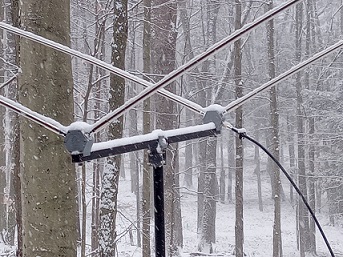The HexTenna Vertical and Dipole and the HexTenna Yagi from Alpha Antenna are both used in amateur radio, but they differ significantly in their design, functionality, and deployment. The HexTenna Vertical & Dipole is a compact, portable, multi-band antenna that can be configured as a vertical or dipole for VHF UHF and HF coverage. The HexTenna Yagi antenna is a directional VHF and UHF antenna known for its gain and fixed beam width, typically used for long-distance communication.
HexTenna Vertical & Dipole:
- Directional: Omnidirectional when deployed as a vertical and bi-directional when deployed as a dipole.
- Gain: Has the gain of a standard 1/4 wave vertical and 3.15 dBi of gain when deployed as a dipole.
- Compact and Portable: Is designed for portable use, offering a small footprint and light weight.
- Multi-Band: Can operate on multiple bands, including HF, VHF, and UHF.
- Configurable: It can be set up as a vertical or dipole.
- Deployment: The HexTenna can be easily deployed using a top mast mount, tripod, or other mounting methods.
- Power Handling: Designed for full legal limit operation.
HexTenna Yagi:
- Directional: The HexTenna Yagi antenna is designed to receive and transmit signals in a specific direction, offering gain.
- Gain: The Yagi antenna is known for its gain, allowing for longer-range communication.
- Beam width: The Yagi has a directional beam width, meaning it is most effective when pointed directly at the target.
- Deployment: Yagi antennas typically require mounting on a mast or heavy-duty tripod.
- Size and Weight: The Yagi antenna can be large and heavy, especially as it is deployed for lower bands.
Key Differences:
- Mounting:
The HexTenna Vertical & Dipole is designed easy mounting on this Specially Designed Surveyor Tripod, while the Yagi antenna is often larger and require more robust mounting that the Alpha Military antenna mast and tripod provides.
- Band Coverage:
The HexTenna Vertical and Dipole and the HexTenna Yagi offer multi-band operation, which are both manually tuned to a specific band by adjusting the telescopic elements.
- Directionality:
Yagi antennas are directional, while the HexTenna can be configured for vertical for omnidirectional operation or as a dipole for bi-directional gain.
- Ease of Deployment:
The HexTenna Vertical & Dipole is generally easier to deploy for temporary or field operations due to its portability and compact design than the Yagi. This is due to only a single pair of elements that need to be tuned vs four elements of the Yagi.
- Cost:
The HexTenna Vertical & Dipole will be less expensive than the HexTenna Yagi version, however, both offer greater versatility and portability.

